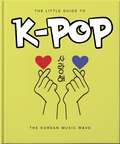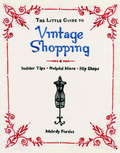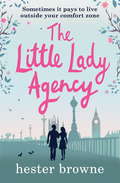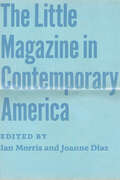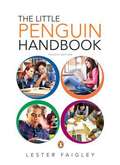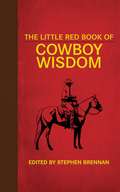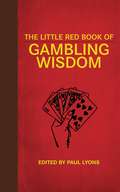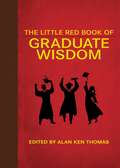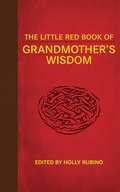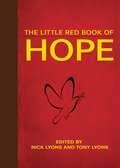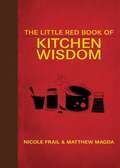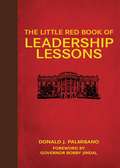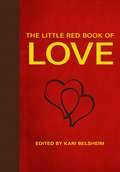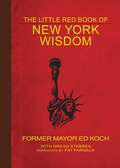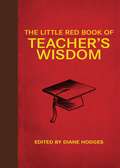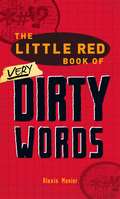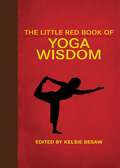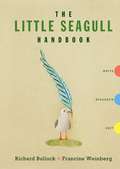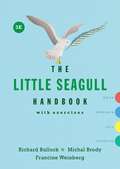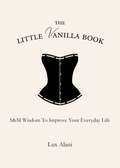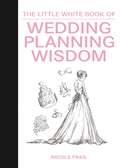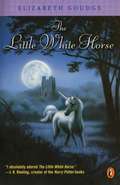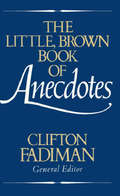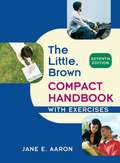- Table View
- List View
The Little Guide to K-POP: The Korean Music Wave (The\little Book Of... Ser.)
by Orange Hippo!K-POP cannot be stopped!Since its large-scale assault on the world stage a decade ago, K-POP has defied a cynical musical industry and defined a generation of musical talent, creating a soundtrack to the 21st century in the process. Today, more than 80 million K-POP albums are sold each year, with tens of billions of streams and MVs to boot, uniting the millions of K-POP fandoms together into one demilitarized, and friendly, army.Much like K-POP blends together the genres of electronic, pop, hip-hop, rock, and R&B, The Little Guide to K-POP fuses together all the facts, stats, quotes, quips, wisdom and trivia you'll need to keep up to speed with this lightning bolt of an evolving genre.From BTS to BlackPink, Seventeen to EXO, Red Velvet to SuperM, and everyone else inbetween, The Little Guide to K-POP celebrates ten years of musical revolution, throwing a bite-size spotlight on the viral dance moves, songs, groups, agencies, MVs and the heart-throbbing idols at the centre of this global cultural phenomenon.'No matter who you are, where you're from, your skin colour, your gender identity; just speak yourself. Find your name and find your voice by speaking yourself.' RM, BTS, at the United Nations, September 20, 2021.
The Little Guide to Vintage Shopping
by Melody FortierA Modern Guide to Vintage Vintage clothing offers couture quality at a fraction of the price. But how can you spot a Dior original in a rack stuffed with Little Black Dresses? Vintage-clothing dealer Melody Fortier demystifies the entire process so you'll know just what to look for, what to avoid, and what to pay. The Little Guide to Vintage Shopping shares insider tips for evaluating quality, selecting problem-free pieces, ensuring the perfect fit and silhouette, and caring for your unique finds. With this savvy guide tucked in your handbag, you'll be ready to hit the streets. From fashion boutiques to flea markets, the hunt for treasures is on!
The Little Lady Agency: the hilarious bestselling rom com from the author of The Vintage Girl (The Little Lady Agency)
by Hester Browne'A delicious, witty story. I loved it! SOPHIE KINSELLAGentlemen! No Little Lady in Your Life? Call the Little Lady Agency: everything organised, from your home to your wardrobe, your social life to you. No funny business or laundry.When Melissa is made unfairly redundant from her job at an estate agents' office, she decides it's time for a change. Instead of working for other people, Melissa will go into business for herself: using her organisational skills to whip the lives of London's socially and romantically challenged men into shape.But then Melissa meets Jonathan, and suddenly she must decide if she can mix business with pleasure . . .***READERS LOVE THE LITTLE LADY AGENCY'A heart-warming love story' *****'Very relaxing, enjoyable, entertaining and diverting' *****'Left me with a huge smile on my face' *****'Like a pair of comfy slippers on a cold night' ********Read the rest of Hester Browne's hilarious Little Lady series:The Little Lady AgencyLittle Lady, Big AppleWhat the Lady Wants
The Little Magazine in Contemporary America
by Ian Morris Joanne DiazLittle magazines have often showcased the best new writing in America. Historically, these idiosyncratic, small-circulation outlets have served the dual functions of representing the avant-garde of literary expression while also helping many emerging writers become established authors. Although changing technology and the increasingly harsh financial realities of publishing over the past three decades would seem to have pushed little magazines to the brink of extinction, their story is far more complicated. In this collection, Ian Morris and Joanne Diaz gather the reflections of twenty-three prominent editors whose little magazines have flourished over the past thirty-five years. Highlighting the creativity and innovation driving this diverse and still vital medium, contributors offer insights into how their publications sometimes succeeded, sometimes reluctantly folded, but mostly how they evolved and persevered. Other topics discussed include the role of little magazines in promoting the work and concerns of minority and women writers, the place of universities in supporting and shaping little magazines, and the online and offline future of these publications. Selected contributors Betsy Sussler, BOMB; Lee Gutkind, Creative Nonfiction; Bruce Andrews, L=A=N=G=U=A=G=E; Dave Eggers, McSweeney’s; Keith Gessen, n+1; Don Share, Poetry; Jane Friedman, VQR; Amy Hoffman, Women’s Review of Books; and more.
The Little Penguin Handbook, Fourth Edition
by Lester FaigleyThe Little Penguin Handbook is a rich resource for students in composition courses and in courses across the curriculum. With more visuals and sample documents, this handy reference gives students just what they need to know about the writing and research processes, while providing extensive coverage of documentation and grammar.
The Little Red Book of Cowboy Wisdom (Little Red Books)
by Johnny D. Boggs Stephen BrennanFrom real, larger-than-life showmen like Buffalo Bill to silver-screen gunslingers like John Wayne, the cowboy has become an international symbol of honor, adventure, valor, daring, and courage. The era of the cowboy lasted from roughly just before the Civil War to the turn of the century, but it created some of the most enduring and popular names of all time: Jesse James, Wyatt Earp, Wild Bill Hickok, and Pat Garrett, just to name a few. And although the days of duels and showdowns are over, the wisdom and values of those times live on.The Little Red Book of Cowboy Wisdom offers the lessons learned and taught by the men of an earlier, simpler era. Chapters include:TenderfeetSix-Gun or High NoonAround the CampfireCowboy LoveOne-LinersAnd more!The cowboy is without a doubt one of the greatest characters in American history--the soul and backbone of a country. This book is filled with some of the greatest and most lively quotations, sayings, and anecdotes ever to come out of the American West.
The Little Red Book of Gambling Wisdom (Little Red Books)
by Paul LyonsFrom Casablanca to The Hustler, from Moby Dick to How I Made $1,000,000 Playing Poker, these widely varied musings address the entire range of human emotion--the highs of excitement of the "juice" down to the depths of despair of losing. Covered here are gaming's universality and history, superstition and luck, players and places, and also every game, from the lowliest back-alley crap shoot to the highest-stakes poker contest and everything in between.You'll find quotable phrases from luminaries like Plato and Tom Wolfe, along with the hard-scrabble advice of Minnesota Fats and Nick the Greek, and humor and pith from the likes of Woody Allen, Charles Bukowski, David Mamet, Groucho Marx, Hunter S. Thompson, and many, many more!
The Little Red Book of Graduate Wisdom (Little Red Books)
by Michael PipperAdvice, inspiration, and consolation for those facing life after school.Sometimes graduates need a gift that is a little more comprehensive than Oh, the Places You'll Go! This small book is packed full of wisdom from those who have completed their years of schooling and lived to tell their tales-or those who haven't, but feel the need to add something to the graduation lexicon anyway. From humorous to profound, there's something for everyone inside:"It might be said now that I have the best of both worlds. A Harvard education and a Yale degree." -John F. Kennedy"A graduation ceremony is an event where the commencement speaker tells thousands of students dressed in identical caps and gowns that 'individuality' is the key to success." -Robert Orben"We don't stop going to school when we graduate." -Carol Burnett"Everyone has a right to a university degree in America, even if it's in Hamburger Technology." -Clive JamesWhether your graduate is feeling excited about his or her future or nervous about facing challenges, The Little Red Book of Graduate Wisdom is the perfect gift to cheer, reassure, and show how proud you are for all that they've accomplished.
The Little Red Book of Grandmother's Wisdom (Little Red Books)
by Holly RubinoFor first-timers, veterans, or those hoping to join the ranks real' soon, here is a collection of more than 250 memorable quotations that capture the ups and downs and all points in between of what it means to be a grandmother and the inherent wisdom, power, and grandchildren-spoiling privileges that come with it. Heartwarming musings, advice, opinions, and observations are drawn from famous grandmothers around the world and those who know them all too well. Illustrated with full-color photos throughout, The Little Red Book of Grandmother's Wisdom is the perfect gift for the beloved bubbe, nonna, or "queen mum" in your life."You have to stay in shape. My grandmother started walking five miles a day when she was sixty. She's ninety-seven today and we don't know where the hell she is." --Ellen DeGeneres"Just like his grandmother, [Barack] just keeps getting up and moving forward . . . with patience and wisdom, and courage and grace." --Michelle Obama"I would say my grandmother would be like my personal god." --Jamie Foxx
The Little Red Book of Hope (Little Red Books)
by Nick Lyons Tony LyonsHope is an interesting thing. Some think it’s foolish, often misplaced, and at rarer times devastating; but more agree that hope is an integral and beautiful part of life, something that implicitly makes us human. We’re always hoping for something—for change, for improvement, or to find peace of mind amid life’s bustling demands. These things are often the subjects of our deepest desires, those things that can bring us true happiness. Fortunately for all of us who count ourselves among the hopeful, there has been plenty of wisdom bestowed from some of the greatest minds and noteworthy individuals throughout history, including:Albert Einstein Albert CamusBarack Obama Benjamin FranklinJohn Lennon George Bernard ShawAbraham Lincoln And many others! The Little Red Book of Hope is an inspired collection of uplifting thoughts about what it is that allows us to persevere; about the primacy of the human spirit, and ultimately, about the redemptive power and vitality of hope.
The Little Red Book of Kitchen Wisdom (Little Red Books)
by Kerri Frail Nicole Frail Matthew MagdaFrom Thomas Keller to Julia Child-hundreds of quotes that are sure to please anyone who loves to cook, bake, drink, and eat.As American chef and food writer James Beard once said, "Food is our common ground, a universal experience." Everyone has a favorite food or meal, a method of cooking or baking they swear by, or a secret ingredient they utilize whenever possible. Food brings friends and family together every day, whether in their dining rooms or at tables in their favorite restaurants.The Little Red Book of Kitchen Wisdom presents thoughts on the happenings in kitchens around the world, from the preparation of ingredients to the consumption of meals and everything in between. This book will include quotes from the most respected chefs in the world (such as Heston Blumenthal, Alice Waters, and Grant Achatz), recognizable celebrity chefs and television personalities (Alton Brown, Mario Batali, Cat Cora), food critics and writers (Michael Pollan, Ruth Reichl, Michael Ruhlman), and various actors, actresses, authors, comedians, and poets who like to eat and talk about it.The mix of professionals and celebrities featured in this book will draw the attention of cooks at every level-professionals, home cooks, and hobbyists-and people who simply love to eat and drink."The only time to eat diet food is while you're waiting for the steak to cook." -Julia Child"I cook with wine, sometimes I even add it to the food." -W.C. Fields"The shared meal elevates eating from a mechanical process of fueling the body to a ritual of family and community, from the mere animal biology to an act of culture." -Michael Pollan"A jazz musician can improvise based on his knowledge of music. He understands how things go together. For a chef, once you have that basis, that's when cuisine is truly exciting." -Charlie Trotter
The Little Red Book of Leadership Lessons (Little Red Books)
by Bobby Jindal Donald J. PalmisanoIn the weeks following the presidential election, the question of what truly makes a good leader is on everyone's mind. Anyone can claim to be a leader in times of calm, but crisis situations separate the true visionaries from the false ones. Recent events in global affairs make it increasingly apparent that nations must cultivate and encourage true leaders--and eschew false ones--if they hope to survive. In the wake of the election, Americans are curious to see how our leaders in government will handle the economic and diplomatic challenges of leading our country.Fortunately, effective leadership is a skill that can be taught, especially through the study of exemplary figures of the past. Donald J. Palmisano explores the vital qualities that every American should look for in a leader by gleaning lessons from great figures throughout history. By analyzing the wisdom of famous leaders, readers will learn about the importance of courage, persistence, decisiveness, and communication as the foundation of a strong leader. The Little Red Book of Leadership Lessons, with quotes from antiquity to the present, provides crucial advice for those who aspire to become effective leaders in any position.
The Little Red Book of Love (Little Red Books)
by Kari Belsheim"At the touch of a lover, everyone becomes a poet."--Plato"Who, being loved, is poor?"?Oscar WildeLove is all around us, and it has inspired the most moving words ever spoken or set to the page. Inside The Little Red Book of Love, you'll find a broad range of sentiments and musings on the topic of love.Love affects everyone in different ways. Inspire yourself and others with the words of: Dr. Seuss Dr. Martin Luther King Jr. Mother Teresa Marilyn Monroe Jane Austen Robert Frost John Lennon And many, many more!
The Little Red Book of New York Wisdom (Little Red Bks.)
by Gregg Stebben Ed Koch Pat FarnackWhether you love its pace or are mystified by its immensity, New York City has a seemingly limitless capacity to spark both refreshingly blunt observations and eloquent descriptions of its daily life and motion. It has inspired countless artists, musicians, and even politicians, all of whom embody the essence of the city: profound, prophetic, quirky, amusing, tough, and amazingly varied.Inside you’ll find words of wisdom from a plethora of noteworthy New Yorkers, including:Joe NamathDonald TrumpEdie FalcoWoody AllenMarilyn MonroeJoan RiversRudy GiulianiBette MidlerSpike LeeAnd many, many more!New York boasts a cast of colorful characters like nowhere else, and in The Little Red Book of New York Wisdom they’ll tell you all about their beloved home, as only real New Yorkers could.
The Little Red Book of Teacher's Wisdom (Little Red Books)
by Dianne HodgesKnown for her motivational and humorous books, Diane Hodges provides the ultimate collection of inspirational quotes and reflective sayings designed to influence, encourage, and motivate educators. <P><P>Complete with full-color illustrations, these quotes inspire teachers to step outside the guidelines and truly reach their students. The musings, advice, and observations are drawn from famous writers, politicians, scientists, actors, comedians, businessmen, and philosophers. Celebrate the wit, wisdom, and creativity that encompass the world of teaching.
The Little Red Book of Very Dirty Words
by Alexis MunierInside this book: The dirtiest words in the English language! And we're not just talking about those infamous seven words you can't say on TV. We're talking about more than 1,000 of the blessedly profane insults, obscenities, and vulgarities that make English the richest--and raunchiest--language on earth. InThe Little Red Book of Very Dirty Words, you'll find the dirtiest of the dirty, along with the most deliciously obscene variations from English-speaking countries around the world. So go ahead, call your ex/boss/landlord a barmy, crop-dusting, kickin', frackin', bloody son-of-a-bitch dickwad. Swear. Loudly. You'll be friggin' glad you did. Because with this nastiest of nasty wordbooks, you'll find talking dirty has never been more fun--or more filthy!
The Little Red Book of Very Dirty Words
by Alexis MunierInside this book: The dirtiest words in the English language!And we're not just talking about those infamous seven words you can't say on TV. We're talking about more than 1,000 of the blessedly profane insults, obscenities, and vulgarities that make English the richest--and raunchiest--language on earth. In The Little Red Book of Very Dirty Words, you'll find the dirtiest of the dirty, along with the most deliciously obscene variations from English-speaking countries around the world. So go ahead, call your ex/boss/landlord a barmy, crop-dusting, kickin', frackin', bloody son-of-a-bitch dickwad. Swear. Loudly. You'll be friggin' glad you did. Because with this nastiest of nasty wordbooks, you'll find talking dirty has never been more fun--or more filthy!
The Little Red Book of Yoga Wisdom (Little Red Books)
by Kelsie BesawIn Hinduism, Buddhism, and Jainism, the word yoga means "spiritual discipline." Modern yoga is thought of mainly in the context of its postures, but the actual meaning of yoga goes much deeper than that. Though its exact history is unknown, the first recorded instance appears in ancient Shamanism, a religion that involved healing its community members, among other functions.Throughout history, yoga has developed and adapted depending on its practicing members. While its original focus was applying and understanding the world, its focus was later changed to the self, with self-enlightenment being the ultimate goal. Later, the poses and meditation became critical elements in practicing yoga, a development introduced by Buddhist teachings.Yoga has many interpretations, and it has many teachers. From ancient yogis such as Buddha to more modern experts such as B. K. S. Iyengar, there is much wisdom to be gleaned from these pages, and there is much that can be discarded. As many say in the yoga world, if something does not work for you, then it is not true for you. There have been countless yogis and yoga experts throughout history, delving into the deepest meanings of yoga as well as scratching its most shallow surface. As readers will discover from this inspirational collection of yoga wisdom, there is no one way to do yoga, see yoga, or feel yoga.
The Little Seagull Handbook
by Richard Bullock Francine WeinbergThe Little Seagull Handbook offers help with specific kinds of writing that college students are expected to undertake.
The Little Seagull Handbook with Exercises (Third Edition)
by Richard Bullock Francine Weinberg Michal BrodyMost handbooks include chapters on various general writing topics (e.g., the writing process or the elements of an argument), but few cover the specific kinds of writing students are assigned to do. The Little Seagull has chapters on reports, analyses, and all the other genres that college students are most often assigned. And because it's so small, so easy to use, and so affordable, it's proven to be a popular alternative to larger (and much more costly) handbooks. The third edition adds a new section on editing the errors that matter―and the option to include free access to InQuizitive for Writers, which provides practice in editing the same errors.
The Little Vanilla Book
by Lux AlaniLace up your corset and embrace your stiletto swagger with this unblushing guide to personal growth using the virtues of (gasp!) S&M.Offering mighty insights on everything from whipping negativity into submission to breaking the bondage of bad self-body image, The Little Vanilla Book gives you the tools you need to awaken the heroine deep inside and open your life to a scintillating new world of self discovery. Within the pages of this loving and bawdy exploration of all things you, former dominatrix Lux Alani uses her personal experiences and research to uncover the surprising truth that some of the primary lessons and practices found in the world of kink aren't just for the kinksters--with the right mindset they're for you too. But wait! If you're nervous that you'll need to buy a paddle and latex catsuit to get your transformation on, don't worry! This isn't about getting into the kink scene or practicing BDSM. Looking at five key aspects of every woman's life: authenticity, confidence, body image, resilience, and fear, The Little Vanilla Book is truly about taking a unique journey to self-love and empowerment--one that shows you how to unchain your courage, reclaim your awesome self, and live your truth with gusto.
The Little White Book of Wedding Planning Wisdom (Little Bks.)
by Nicole FrailFrom engagement to honeymoon, this little book will provide you with all the basics to start planning your dream wedding. The moments after accepting a marriage proposal are exciting and romantic, but they can also be overwhelming and sometimes even confusing. Immediately after sharing the news, brides are often bombarded with questions: Have you set a date? What are your colors? Who are your bridesmaids? Where will you register? If you’re a bride-to-be who isn’t sure how to even begin answering those questions and others like them, or who has a head full of ideas but no way to organize them, The Little White Book of Wedding Planning Wisdom is the guide you need. This book will provide you with advice related to every step of the process--from announcing your engagement, to booking a venue, to choosing the perfect date. You will learn when to book florists, caterers, and entertainers--and which questions to ask them before you do so. More than a simple manual, this book also features reflections and quotes from brides who share their own real-life experiences choosing their first songs, trying on one dress after another, and worrying about centerpieces, seating charts, and writing the perfect vows. At a convenient size, The Little White Book of Wedding Planning Wisdom can be easily slipped into your purse to consult as you move from one appointment to another, whether you’re meeting with potential photographers, cake bakers, or jewelers.
The Little White Horse
by Elizabeth GoudgeWhen orphan Maria arrives at Moonacre Manor, she feels like she's come home. Her new guardian is kind, like an old friend. However, beneath the beauty and comfort lies a tragedy. Maria is determined to find out about it, change it, and give her own life story a happy ending.
The Little, Brown Book of Anecdotes
by Clifton FadimanA collection of biographical anecdotes about famous people.
The Little, Brown Compact Handbook with Exercises (7th Edition)
by Jane E. AaronThe Little, Brown Compact Handbook with Exercises packages the authority and currency of its best-selling parent, The Little, Brown Handbook, in a briefer book with spiral binding, tabbed dividers, and more than 150 exercises. Concise and accessible, The Little, Brown Compact Handbook helps writing students find what they need and then use what they find. It provides clear explanations of the writing process, grammar, usage, critical thinking, and argument. Its thorough, up-to-date coverage of research writing stresses the library as Web gateway, evaluation and synthesis of print and online sources, and intellectual honesty. It provides the latest documentation guidelines in MLA, APA, Chicago, and CSE styles.
